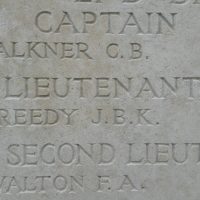Preedy, JBK
(1883 - 1917)

Key Facts
DATE OF BIRTH:
12th June 1883
YEARS ATTENDED THE COLLEGE:
1895 - 1900
HOME ADDRESS WHEN AT THE COLLEGE:
19 Acacia Grove, West Dulwich
REGIMENT
2nd (City of London) Battalion, London Regiment
FINAL RANK:
Lieutenant
DATE OF DEATH:
26th October 1917
AGE AT DEATH:
34
WHERE HE DIED (or was wounded)
Poelcappelle
LOCATION OF GRAVE OR MEMORIAL:
Tyne Cot Memorial. Panel 148 to 150
Lieutenant John Benjamin Knowlton Preedy
John was born on June 12th 1883, the only child of a hatmaker, also called John Preedy, and his wife, Emily. He was at the College for five and a half years, starting in the summer of 1895. At the end of 1900 he left, whilst a member of the Classical Remove, to attend a boarding school in Cowley, Oxfordshire. In 1903 he took up a place at King’s College, London, graduating three years later with a Third Class degree in Classics. A year later he returned to university, this time at U.C.L., where he took an M.A. in Classical Archaeology. He passed in 1909 and, the following year, his thesis – “The Chariot Group of the Mausoleum” – was published in The Journal of Hellenic Studies. By this point he was working at the County Grammar School at Melton Mowbray in Leicestershire, where he also established the school Scouts group. In 1911 he returned to London to work as a Secretary in the London University Extension Department, a position which also saw him taking tutorials for undergraduates.
On November 1st 1914, several months after Britain had declared war, John volunteered as a member of the University of London O.T.C., taking up a commission with the same unit later that month. He spent over two years involved with the training of recruits and cadets, much of it based at Lichfield, without having left England to see action. In July 1917 he transferred to the 2nd Battalion London Regiment and, that September, went to the front for the first time with his new regiment. Weeks later, on the 26th October 1917, he was killed by a shell at Poelcappelle, near Ypres. His widow, Florence, whom he had married in March of that year, was pregnant at the time of his death, later giving birth to a son, who would also be named John, in early 1918. His mother, Emily, marked his passing by donating a fund to allow the annual purchase of books for the Central Library at London University.
